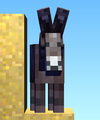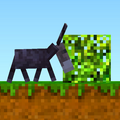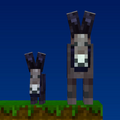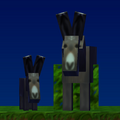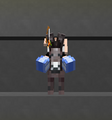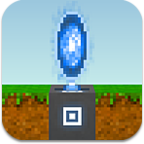Donkey: Difference between revisions
>McClaw No edit summary |
>Hdjensofjfnen No edit summary |
||
| (3 intermediate revisions by 2 users not shown) | |||
| Line 1: | Line 1: | ||
[[File:Donkey.png|right|thumb|Donkey]] | [[File:Donkey.png|right|thumb|Donkey]] | ||
'''Donkeys''' are passive creatures found throughout a [[world]]. They are the most handy creatures in the game and can be ridden to speed up a [[blockhead]]'s travel. | '''Donkeys''' are passive creatures found throughout a [[world]]. They are among the most handy creatures in the game and can be ridden to speed up a [[blockhead]]'s travel. A donkey's preferred [[food]] is [[carrot]]s. | ||
==Appearance== | ==Appearance== | ||
| Line 16: | Line 16: | ||
While donkeys have no innate fear of blockheads, they will attempt to flee from one that has attacked them. Adult donkeys tend to be slower than young ones and actually "run" slower than a blockhead can pursue. | While donkeys have no innate fear of blockheads, they will attempt to flee from one that has attacked them. Adult donkeys tend to be slower than young ones and actually "run" slower than a blockhead can pursue. | ||
There is no noticeable difference in behavior between different breeds (colors) of donkeys. | |||
===Hunger=== | ===Hunger=== | ||
Beginning in version 1.7, donkeys have a hunger bar that steadily decreases. Spawning a baby donkey will sharply reduce a donkey's hunger bar. It is restored a large amount when the donkey eats a carrot, either by moving over one that is loose on the ground or passing a [[Feeder Chest]] that contains a carrot. A tamed donkey's hunger bar may be viewed by tapping on it and selecting the button with its name, but will also be visible over a donkey that is sufficiently hungry. | Beginning in [[Game updates/20180314|version 1.7]], donkeys have a hunger bar that steadily decreases. Spawning a baby donkey will sharply reduce a donkey's hunger bar. It is restored a large amount when the donkey eats a carrot, either by moving over one that is loose on the ground or passing a [[Feeder Chest]] that contains a carrot. A tamed donkey's hunger bar may be viewed by tapping on it and selecting the button with its name, but will also be visible over a donkey that is sufficiently hungry. | ||
===Taming=== | ===Taming=== | ||
| Line 50: | Line 52: | ||
To mount and ride an untamed donkey, a blockhead must [[Crafting|craft]] and then use a [[Carrot On A Stick|carrot on a stick]] on the donkey. In doing so, a blockhead will climb and mount the donkey and dangle the carrot on a stick in front of the donkey to coerce it walk. The donkey walks at a faster pace than a blockhead by foot and is controlled by tilting the game device in the direction of travel. Donkeys are also able to jump over small obstacles and over changes of height that are up to at least three blocks high by swiping the game device UP while tilting the game device in the direction of travel. | To mount and ride an untamed donkey, a blockhead must [[Crafting|craft]] and then use a [[Carrot On A Stick|carrot on a stick]] on the donkey. In doing so, a blockhead will climb and mount the donkey and dangle the carrot on a stick in front of the donkey to coerce it walk. The donkey walks at a faster pace than a blockhead by foot and is controlled by tilting the game device in the direction of travel. Donkeys are also able to jump over small obstacles and over changes of height that are up to at least three blocks high by swiping the game device UP while tilting the game device in the direction of travel. | ||
Version 1.7 introduces an optional d-pad controller for moving while riding. | [[Game updates/20180314|Version 1.7]] introduces an optional d-pad controller for moving while riding. | ||
Dismounting is done by tapping anywhere but on a control. Beginning with version 1.7, this calls up a button instead of automatically dismounting. | Dismounting is done by tapping anywhere but on a control. Beginning with [[Game updates/20180314|version 1.7]], this calls up a button instead of automatically dismounting. | ||
The carrot on a stick does not need to remain the selected item during a ride. It can even be shifted into a nested slot where it can't be viewed and the ride will continue uninterrupted. | The carrot on a stick does not need to remain the selected item during a ride. It can even be shifted into a nested slot where it can't be viewed and the ride will continue uninterrupted. | ||
| Line 67: | Line 69: | ||
==Breeding== | ==Breeding== | ||
Beginning with version 1.7, donkeys may produce new breeds (colors) when spawning babies. A baby donkey will normally be the same breed as its parent, but will sometimes be the next breed in the sequence. | Beginning with version 1.7, donkeys may produce new breeds (colors) when spawning babies. A baby donkey will normally be the same breed as its parent, but will sometimes be the next breed in the sequence -- or the previous. The full list of donkey breeds is: | ||
*Gray (original) | *Gray (original) | ||
*Brown | *Brown | ||
| Line 80: | Line 82: | ||
*White | *White | ||
*Rainbow | *Rainbow | ||
Rainbow donkeys will occasionally breed a gray [[unicorn]]. | |||
==Trivia== | ==Trivia== | ||
Latest revision as of 20:49, 1 October 2019
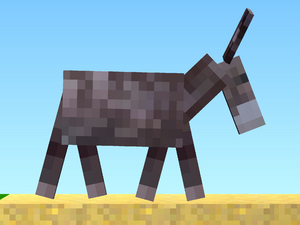
Donkeys are passive creatures found throughout a world. They are among the most handy creatures in the game and can be ridden to speed up a blockhead's travel. A donkey's preferred food is carrots.
Appearance
Donkeys are large creatures with an appearance smaller than a horse. They are initially gray in color with long ears, a short tail, and a short dark mane along the back of the neck; breeding produces donkeys of different colors.
Small/young donkeys are very similar in appearance, but shorter and slightly less bulky.
Where Found
Donkeys are known to spawn or be seen wandering near carrots and carrot plants in any warm biome region. Occasionally, a donkey will appear in a subpolar or mountain region, but this is rare.
Donkeys can also spawn as baby donkeys from adult donkeys. See Breeding (below).
Behavior
Donkeys are typically stubborn creatures and wander aimlessly over the ground. A donkey's behavior usually consists of a few steps of movement then stopping to look at its surroundings before resuming its aimless movement. When stopped, a donkey will sometimes lower its head as if grazing and, at random, bray. Younger donkeys have a higher tone than when mature. Donkeys do not have a particular pattern to their movement and are able to climb blocks that are at most a one-block change in height. They do however, stay in the vicinity of carrots and carrot plants and do not stray too far from these.
While donkeys have no innate fear of blockheads, they will attempt to flee from one that has attacked them. Adult donkeys tend to be slower than young ones and actually "run" slower than a blockhead can pursue.
There is no noticeable difference in behavior between different breeds (colors) of donkeys.
Hunger
Beginning in version 1.7, donkeys have a hunger bar that steadily decreases. Spawning a baby donkey will sharply reduce a donkey's hunger bar. It is restored a large amount when the donkey eats a carrot, either by moving over one that is loose on the ground or passing a Feeder Chest that contains a carrot. A tamed donkey's hunger bar may be viewed by tapping on it and selecting the button with its name, but will also be visible over a donkey that is sufficiently hungry.
Taming
- See also: Pet
Donkeys are tamed by feeding them carrots; both baby and adult donkeys may be tamed. Once tamed, a donkey will be assigned a random name that will appear over it. It can then be tapped on to show a menu with three buttons: Set Free, Ride, and the donkey's name.
Tapping "Set Free" will make the donkey no longer tamed, prompting it to bray and jump. It usually can be re-tamed by feeding it once.
Tapping "Ride" will cause the active blockhead to climb up on the selected donkey and ride it. See Riding (below).
Tapping the donkey's name button will call up a window displaying the donkey's health and hunger bars as well as the donkey's name. The donkey can be renamed by tapping on the pencil button to the right of the donkey's name.
Health
- See also: Creature Hit Chart
Prior to the introduction of sharks and cave trolls, donkeys had the most health of any creature in the game, typically taking two to four hits from a weapon or tool to be killed. Small donkeys have as much health as the larger ones. Whether dying on its own or killed, a dying donkey makes a distinctive braying sound before falling to the ground. A tamed donkey's health bar may be viewed by tapping on it and selecting the button with its name.
Uses
Donkeys are a source of three things:
- Travel - Tapping an adult donkey with a carrot on a stick will allow a blockhead to mount the donkey and ride it, allowing for quicker travel over land. Tamed donkeys may be ridden without any special item.
- Leather - Randomly dropped by a donkey when it dies.
- Carrots - Randomly dropped by a donkey when it dies.
- (They are reported to be the source for breeding unicorns.)
Only full-sized donkeys will drop items.
Riding
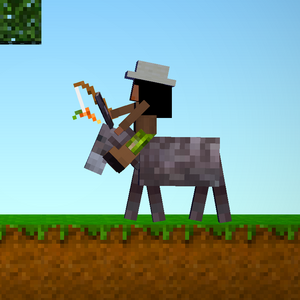
For a quicker method of traveling on land, blockheads are able to mount and ride donkeys.
Tamed donkeys may be ridden by tapping on the donkey and selecting "Ride".
To mount and ride an untamed donkey, a blockhead must craft and then use a carrot on a stick on the donkey. In doing so, a blockhead will climb and mount the donkey and dangle the carrot on a stick in front of the donkey to coerce it walk. The donkey walks at a faster pace than a blockhead by foot and is controlled by tilting the game device in the direction of travel. Donkeys are also able to jump over small obstacles and over changes of height that are up to at least three blocks high by swiping the game device UP while tilting the game device in the direction of travel.
Version 1.7 introduces an optional d-pad controller for moving while riding.
Dismounting is done by tapping anywhere but on a control. Beginning with version 1.7, this calls up a button instead of automatically dismounting.
The carrot on a stick does not need to remain the selected item during a ride. It can even be shifted into a nested slot where it can't be viewed and the ride will continue uninterrupted.
A donkey can be ridden through any space at least two blocks high, but not through doors. If there is a solid block above the donkey, the rider's head will appear to be inside the block but will take no harm.
While riding a donkey, a blockhead will continue to pick up loose items it passes in front of. Note that as of version 1.4, the rider is fully elevated one block above the ground. While its donkey is jumping, a riding Blockhead will pick up loose items in the spaces it intersects.
Donkeys will swim if ridden into water. They aren't terribly fast swimmers, and sometimes appear to be completely submerged. It may be necessary to make a donkey "jump" to clear an underwater rise or keep its head in air.
Riding a tamed donkey may partially restore its health.
Riding any donkey over a loose carrot may allow the donkey to eat it. This may prompt the donkey to jump and bray as well.
Breeding
Beginning with version 1.7, donkeys may produce new breeds (colors) when spawning babies. A baby donkey will normally be the same breed as its parent, but will sometimes be the next breed in the sequence -- or the previous. The full list of donkey breeds is:
- Gray (original)
- Brown
- Black
- Blue
- Green
- Yellow
- Orange
- Red
- Purple
- Pink
- White
- Rainbow
Rainbow donkeys will occasionally breed a gray unicorn.
Trivia
Donkeys are domesticated animals of the species equus africanus asinus of the horse family Equidae, descended from the African wild ass.
Gallery
-
A front view of a donkey
-
A donkey near an orange tree on a hillside
-
A young donkey
-
Adult and young donkeys side-by-side
-
Adult and young donkeys in HD
-
Donkeys can be ridden in water
-
Riders can be "inside" blocks when on donkeys
